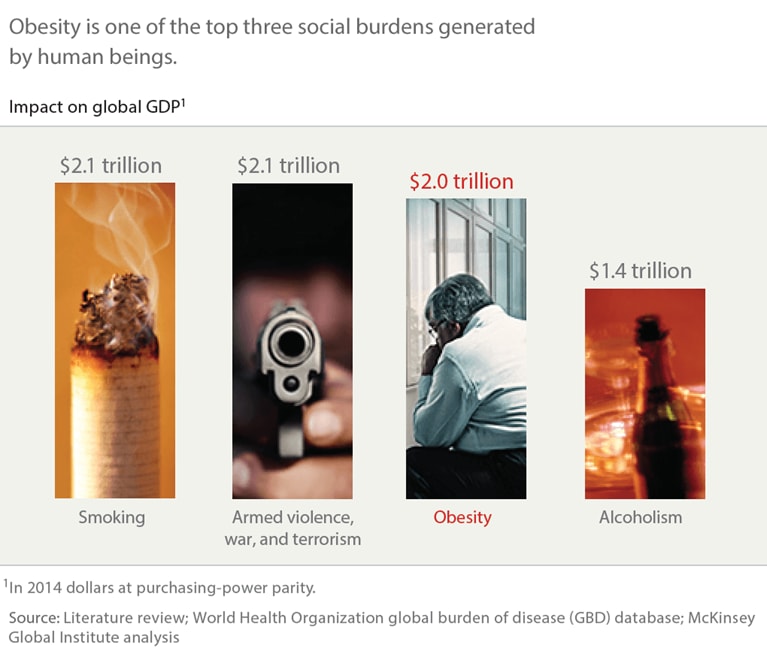
Obesity is a critical global issue that requires a comprehensive, international intervention strategy. More than 2.1 billion people—nearly 30 percent of the global population—are overweight or obese.1 That's almost two and a half times the number of adults and children who are undernourished. Obesity is responsible for about 5 percent of all deaths a year worldwide, and its global economic impact amounts to roughly $2 trillion annually, or 2.8 percent of global GDP—nearly equivalent to the global impact of smoking or of armed violence, war, and terrorism.
And the problem—which is preventable—is rapidly getting worse. If the prevalence of obesity continues on its current trajectory, almost half of the world's adult population will be overweight or obese by 2030.
Much of the global debate on this issue has become polarized and sometimes deeply antagonistic. Obesity is a complex, systemic issue with no single or simple solution. The global discord surrounding how to move forward underscores the need for integrated assessments of potential solutions. Lack of progress on these fronts is obstructing efforts to address rising rates of obesity.
A new McKinsey Global Institute (MGI) discussion paper, Overcoming obesity: An initial economic analysis, seeks to overcome these hurdles by offering an independent view on the components of a potential strategy. MGI has studied 74 interventions (in 18 areas) that are being discussed or piloted somewhere around the world to address obesity, including subsidized school meals for all, calorie and nutrition labeling, restrictions on advertising high-calorie food and drinks, and public-health campaigns. We found sufficient data on 44 of these interventions, in 16 areas.
Although the research offers an initial economic analysis of obesity, our analysis is by no means complete. Rather, we see our work on a potential program to address obesity as the equivalent of the maps used by 16th-century navigators. Some islands were missing and some continents misshapen in these maps, but they were still helpful to the sailors of that era. We are sure that we have missed some interventions and over- or underestimated the impact of others. But we hope that our work will be a useful guide and a starting point for efforts in the years to come, as we and others develop this analysis and gradually compile a more comprehensive evidence base on this topic.
We have focused on understanding what it takes to address obesity by changing the energy balance of individuals through adjustments in eating habits or physical activity. However, some important questions we have not yet addressed require considerable further research. These questions include the role of different nutrients in affecting satiety hormones and metabolism, as well as the relationship between the gut microbiome and obesity. As more clarity develops in these research areas, we look forward to the emergence of important insights about which interventions are likely to work and how to integrate them into an antiobesity drive.
The main findings of this discussion paper include:
- Existing evidence indicates that no single intervention is likely to have a significant overall impact. A systemic, sustained portfolio of initiatives, delivered at scale, is needed to reverse the health burden. Almost all the identified interventions (exhibit) are cost effective for society—savings on healthcare costs and higher productivity could outweigh the direct investment required by the intervention when assessed over the full lifetime of the target population. In the United Kingdom, for instance, such a program could reverse rising obesity, saving the National Health Service about $1.2 billion a year.
- Education and personal responsibility are critical elements of any program aiming to reduce obesity, but they are not sufficient on their own. Other required interventions rely less on conscious choices by individuals and more on changes to the environment and societal norms. They include reducing default portion sizes, changing marketing practices, and restructuring urban and education environments to facilitate physical activities.
- No individual sector in society can address obesity on its own—not governments, retailers, consumer-goods companies, restaurants, employers, media organizations, educators, healthcare providers, or individuals. Capturing the full potential impact requires engagement from as many sectors as possible. Successful precedents suggest that a combination of top-down corporate and government interventions, together with bottom-up community-led ones, will be required to change public-health outcomes. Moreover, some kind of coordination will probably be required to capture potentially high-impact industry interventions, since any first mover faces market-share risks.
- Implementing an obesity-abatement program on the required scale will not be easy. We see four imperatives:
- as many interventions as possible should be deployed at scale and delivered effectively by the full range of sectors in society;
- understanding how to align incentives and build cooperation will be critical to success
- there should not be an undue focus on prioritizing interventions, as this can hamper constructive action; and
- while investment in research should continue, society should also engage in trial and error, particularly where risks are low.
Cost-effective interventions to reduce obesity in the United Kingdom include controlling portion sizes and reducing the availability of high-calorie foods.

The evidence base on the clinical and behavioral interventions to reduce obesity is far from complete, and ongoing investment in research is an imperative. However, in many cases this requirement is proving a barrier to action. It need not be so. Rather than wait for perfect proof of what works, we should experiment with solutions, especially in the many areas where interventions are low risk. We have enough knowledge to do more.
